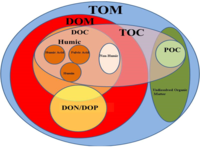
Photo from wikipedia
Abstract Climate change and particularly increasing frequency of drought events during the vegetation period may threaten tree vitality and forest biomass productivity in many temperate regions in the future. In… Click to show full abstract
Abstract Climate change and particularly increasing frequency of drought events during the vegetation period may threaten tree vitality and forest biomass productivity in many temperate regions in the future. In that context, the identification of critical environmental factors and a better understanding of their impact on forests are decisive. The water balance is recognized as one of the most important soil factors for stand productivity in temperate forests. Hence, the consequences of short or long term climate change might vary considerably spatially in function of soil type within a given forest. Our study objective was to assess the impact of contrasting soil types on the water balance and stand growth of a beech (Fagus sylvatica) forest ecosystem of similar age and management during four climatically contrasting years. The experimental forest site of Montiers presents different soils with contrasting physicochemical properties (Dystric Cambisol, Eutric Cambisol and Rendzic Leptosol) monitored to quantify water fluxes and stand biomass increment. Using data collected over the period 2012–2015, including a particularly dry year (−24% precipitations in 2015), we also quantified the impact of water shortage on stand productivity at the annual scale as a function of soil type. We evidenced important differences in soil water holding capacities (SWHC) along the studied soil sequence, ranging between 57 mm for the Rendzic Leptosol downhill over limestone and 205 mm for the Dystric Cambisol uphill over detrital sediments. The results show that the canopy intercepted the same amount of incident rainfall in the three plots and that there were no significant differences in annual soil moisture dynamics among the studied soils. We evidenced different rooting patterns depending on soil type. Under a same climate and with stand, site exposition and solar radiation equivalency, trees transpiration was the evident primary driver of the stand potential to produce aboveground biomass. Soil water holding capacity, annual trees transpiration and aboveground biomass production increased in that order: Rendzic Leptosol
Journal Title: Forest Ecology and Management
Year Published: 2017
Link to full text (if available)
Share on Social Media: Sign Up to like & get
recommendations!